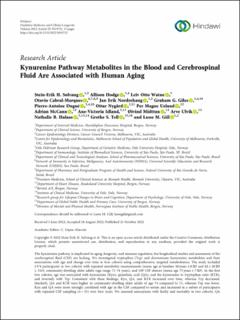Kynurenine Pathway Metabolites in the Blood and Cerebrospinal Fluid Are Associated with Human Aging
| dc.contributor.author | Solvang, Stein-Erik Hafstad | |
| dc.contributor.author | Hodge, Allison | |
| dc.contributor.author | Watne, Leiv | |
| dc.contributor.author | Cabral-Marques, Otavio | |
| dc.contributor.author | Nordrehaug, Jan Erik | |
| dc.contributor.author | Giles, Graham G. | |
| dc.contributor.author | Dugué, Pierre-Antoine | |
| dc.contributor.author | Nygård, Ottar Kjell | |
| dc.contributor.author | Ueland, Per Magne | |
| dc.contributor.author | McCann, Adrian | |
| dc.contributor.author | Idland, Ane-Victoria | |
| dc.contributor.author | Midttun, Øivind | |
| dc.contributor.author | Ulvik, Arve | |
| dc.contributor.author | Halaas, Nathalie Bodd | |
| dc.contributor.author | Tell, Grethe S. | |
| dc.contributor.author | Melvær, Giil Lasse | |
| dc.date.accessioned | 2022-12-30T11:35:01Z | |
| dc.date.available | 2022-12-30T11:35:01Z | |
| dc.date.created | 2022-11-11T10:45:11Z | |
| dc.date.issued | 2022 | |
| dc.identifier.issn | 1942-0900 | |
| dc.identifier.uri | https://hdl.handle.net/11250/3040073 | |
| dc.description.abstract | The kynurenine pathway is implicated in aging, longevity, and immune regulation, but longitudinal studies and assessment of the cerebrospinal fluid (CSF) are lacking. We investigated tryptophan (Trp) and downstream kynurenine metabolites and their associations with age and change over time in four cohorts using comprehensive, targeted metabolomics. The study included 1574 participants in two cohorts with repeated metabolite measurements (mean age at baseline 58 years ± 8 SD and 62 ± 10 SD ), 3161 community-dwelling older adults (age range 71-74 years), and 109 CSF donors (mean age 73 years ± 7 SD). In the first two cohorts, age was associated with kynurenine (Kyn), quinolinic acid (QA), and the kynurenine to tryptophan ratio (KTR), and inversely with Trp. Consistent with these findings, Kyn, QA, and KTR increased over time, whereas Trp decreased. Similarly, QA and KTR were higher in community-dwelling older adults of age 74 compared to 71, whereas Trp was lower. Kyn and QA were more strongly correlated with age in the CSF compared to serum and increased in a subset of participants with repeated CSF sampling (n = 33) over four years. We assessed associations with frailty and mortality in two cohorts. QA Hindawi Oxidative Medicine and Cellular Longevity Volume 2022, Article ID 5019752, 15 pages https://doi.org/10.1155/2022/5019752 and KTR were most strongly associated with mortality and frailty. Our study provides robust evidence of changes in tryptophan and kynurenine metabolism with human aging and supports links with adverse health outcomes. Our results suggest that aging activates the inflammation and stress-driven kynurenine pathway systemically and in the brain, but we cannot determine whether this activation is harmful or adaptive. We identified a relatively stronger age-related increase of the potentially neurotoxic end-product QA in brain. | en_US |
| dc.language.iso | eng | en_US |
| dc.publisher | Hindawi | en_US |
| dc.rights | Navngivelse 4.0 Internasjonal | * |
| dc.rights.uri | http://creativecommons.org/licenses/by/4.0/deed.no | * |
| dc.title | Kynurenine Pathway Metabolites in the Blood and Cerebrospinal Fluid Are Associated with Human Aging | en_US |
| dc.type | Journal article | en_US |
| dc.type | Peer reviewed | en_US |
| dc.description.version | publishedVersion | en_US |
| dc.rights.holder | Copyright 2022 The Author(s) | en_US |
| dc.source.articlenumber | 5019752 | en_US |
| cristin.ispublished | true | |
| cristin.fulltext | original | |
| cristin.qualitycode | 1 | |
| dc.identifier.doi | 10.1155/2022/5019752 | |
| dc.identifier.cristin | 2072335 | |
| dc.source.journal | Oxidative Medicine and Cellular Longevity | en_US |
| dc.identifier.citation | Oxidative Medicine and Cellular Longevity. 2022, 2022, 5019752. | en_US |
| dc.source.volume | 2022 | en_US |
Tilhørende fil(er)
Denne innførselen finnes i følgende samling(er)
-
Department of Clinical Science [2308]
-
Registrations from Cristin [9656]

